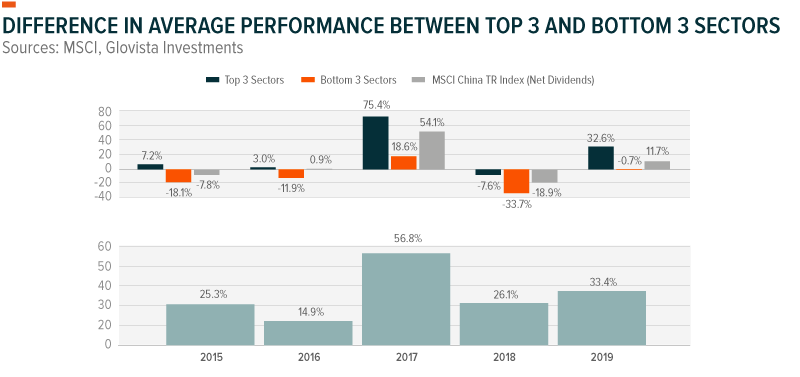Last month, Glovista Investments – a U.S.-based investment manager – launched the China Sector Rotation Strategy. The strategy utilizes Global X’s China Sector ETFs – a suite of funds that track each of the eleven major economic sectors identified by the Global Industry Classification Standard (GICS®) in China. Leveraging Glovista’s extensive experience in emerging market investing, the strategy seeks to outperform the MSCI China Index by 3% per year by tilting across Chinese sectors based on top-down global macro views, sector and industry analysis, ETF constituent analysis, and bottom-up holdings analysis on the largest sector ETF constituents.
In this interview we ask Glovista’s Deputy Chief Investment Officer, Darshan Bhatt, about China, sector investing in the world’s second largest economy, and how investors should approach the space.
1. Why the emphasis on China?
Historically, many investors had gained broad exposure to China, looking to capture its growth through emerging market (EM) index funds or through single-country ETFs targeting a broad basket of Chinese stocks. But after decades of explosive economic expansion, China has developed a large and dynamic economy that rivals the powerful and multi-faceted economies in the developed world. It now boasts the world’s largest population, second largest gross domestic product (GDP), and over 3,000 listed companies representing over 10% of global market capitalization. We believe that as China continues to become a bigger part of the global economy, that investors will increasingly look to break it out of the broad emerging markets bucket (much like Japan was broken off as its own region in the 1990s) and look for more tactical ways to harness returns from the country’s equity markets.
2. Why have you decided to look at China through a sector lens?
Sector-based investing allows investors to more precisely toggle their exposures to this complex market, taking into account a variety of factors such as growth expectations, valuations, macro-level risks, volatility, and momentum, among others. These strategies can be implemented with consideration for the unique dynamics underlying China’s centrally-planned economy, state ownership, regional tensions, relations with the US, and domestic demographics.
We believe that tactically tilting to certain sectors, based on a variety of factors, can help investors harvest potential alpha opportunities. While many investors consider sectors-based investing for their US exposures, we think sectors are even more ripe for alpha in China where the dispersion in returns has been dramatic.1
Data as of Oct 16, 2019. Quoted annual performance represents the average of the top and bottom three performing sector indices comprising the MSCI China TR Index (Net). Information shown is for illustrative purposes only and does not represent an actual investment. Performance gap may differ slightly due to rounding. Due to the recent sector re-classifications, Real Estate sector is only in analysis done between 2017-2019 and Communications sector only in 2019 analysis.
*Based on Total Return (Net Dividends) in U.S. dollar terms. Performance data quoted represents past results. Past performance is no guarantee of future results. Source: MSCI. Indexes are unmanaged, their returns do not reflect any fees, expenses or sales charges, and are not available for direct investment.
3. What factors or indicators do you look at when considering which sectors in China look most attractive?
We use a host a data points and lengthy analysis to make our allocation decisions. For example, our global macro module seeks to tilt to Chinese sectors based on the outlook for near-term economic growth drivers, including: consumption, investment, net exports versus government spending, and currency, as well as views on global style drifts and investor positioning. The sector and industry analysis module incorporates tilts based on industry-specific themes, margin and growth dynamics, regulatory impact, and technical analysis.
4. Which sectors do you currently find the most appealing?
As China’s economy evolves, growth opportunities are becoming more narrowly concentrated in specific sectors. In shifting towards a consumption-oriented economy, consumer-driven sectors are most attractive given the impact of wage growth, migration into cities, and an expansion of internet connectivity. China’s enormous middle class, larger than the US population, spends more time and money on goods and services, which span across leisure, retail, healthcare, and technology segments of discretionary sectors.
Related ETFs
Global X’s China Sector Suite includes ETFs covering each of the 11 sectors recognized by the Global Industry Classification System (GICS). By providing investors with access to each major economic sector in China, these funds allow for more targeted exposures and tactical strategies for harnessing opportunities within the world’s second largest economy.
- CHIC: Global X MSCI China Communication Services ETF
- CHIQ: Global X MSCI China Consumer Discretionary ETF
- CHIS: Global X MSCI China Consumer Staples ETF
- CHIH: Global X MSCI China Health Care ETF
- CHIE: Global X MSCI China Energy ETF
- CHIX: Global X MSCI China Financials ETF
- CHII: Global X MSCI China Industrials ETF
- CHIK: Global X MSCI China Information Technology ETF
- CHIM: Global X MSCI China Materials ETF
- CHIR: Global X MSCI China Real Estate ETF
- CHIU: Global X MSCI China Utilities ETF
 Global X Research Team
Global X Research Team